Honeywell International Bundle
How Does Honeywell International Thrive in a Changing World?
Honeywell International, a global force in technology and manufacturing, consistently shapes industries from aerospace to building technologies. Its impressive financial performance, including strong Q1 2024 results, highlights its robust growth and operational efficiency. Understanding Honeywell International SWOT Analysis is key for investors and anyone tracking industrial advancements.
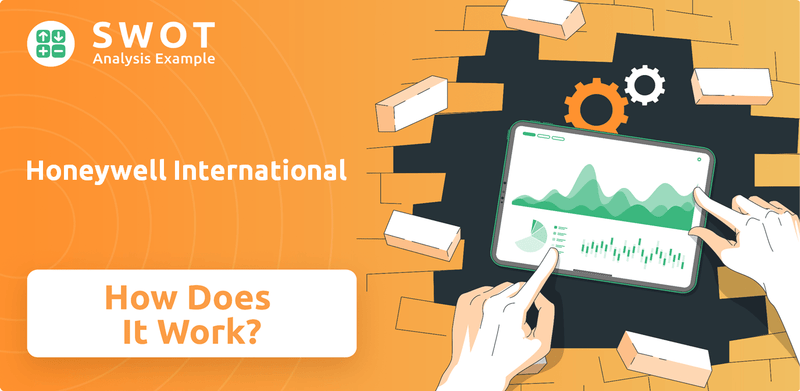
This deep dive into the Honeywell company explores its structure, divisions, and how Honeywell works across diverse sectors. We'll examine Honeywell's products, its role in the aerospace industry, and its contributions to sustainability. Analyzing Honeywell's business model provides crucial insights for investors and industry observers alike, revealing the strategies behind its enduring success and its ability to navigate market shifts.
What Are the Key Operations Driving Honeywell International’s Success?
Honeywell International is a global technology and manufacturing leader, creating value through its integrated approach to technology and manufacturing. The company operates across four main segments: Aerospace, Building Technologies, Performance Materials and Technologies (PMT), and Safety and Productivity Solutions (SPS). This structure allows Honeywell to serve a diverse customer base with a wide range of products and services.
The company's core operations involve extensive research and development, advanced manufacturing, and a sophisticated supply chain. Honeywell's focus on digital transformation and customer-centric solutions enhances operational efficiency, safety, and productivity. This approach has positioned the company as a key player in multiple industries, driving innovation and sustainable practices.
Honeywell's value proposition lies in its ability to deliver integrated solutions that improve operational efficiency, enhance safety, and reduce environmental impact. This is achieved through a combination of deep engineering expertise, a strong intellectual property portfolio, and a customer-focused approach. For more insights, you can explore the Growth Strategy of Honeywell International.
Provides aircraft engines, avionics, and services for commercial, defense, and space applications. Serves aircraft manufacturers, airlines, and military customers. In 2024, the Aerospace segment generated approximately $12.8 billion in revenue, demonstrating its significant contribution to the company's overall performance.
Offers products, software, and services to make commercial buildings more efficient, safe, and secure. Caters to building owners, developers, and facility managers. This segment accounted for roughly $6.1 billion in revenue in 2024, reflecting its importance in the smart buildings market.
Delivers advanced materials, process technologies, and automation solutions for industries like refining, petrochemicals, and pharmaceuticals. Serves chemical companies, refiners, and industrial manufacturers. PMT generated around $11.3 billion in revenue in 2024, highlighting its role in industrial innovation.
Provides safety products, gas detection technology, and productivity solutions, including mobile computers and scanning equipment. Targets industrial workers and supply chain operations. SPS brought in approximately $7.3 billion in revenue in 2024, showing its impact on workplace safety and efficiency.
Honeywell's operational effectiveness stems from its deep engineering expertise, extensive intellectual property, and a customer-centric approach. This leads to improved operational efficiency and enhanced safety. The company's commitment to research and development is substantial, with investments in areas like artificial intelligence and cybersecurity.
- Research and Development: Honeywell invests heavily in R&D to develop new technologies and improve existing products, with R&D spending reaching approximately $2.2 billion in 2024.
- Manufacturing: Operates numerous global facilities with advanced manufacturing capabilities.
- Supply Chain: Maintains a sophisticated global supply chain to ensure timely delivery of products and services.
- Digital Transformation: Focuses on digital transformation to streamline processes and improve efficiency.
Honeywell International SWOT Analysis
- Complete SWOT Breakdown
- Fully Customizable
- Editable in Excel & Word
- Professional Formatting
- Investor-Ready Format
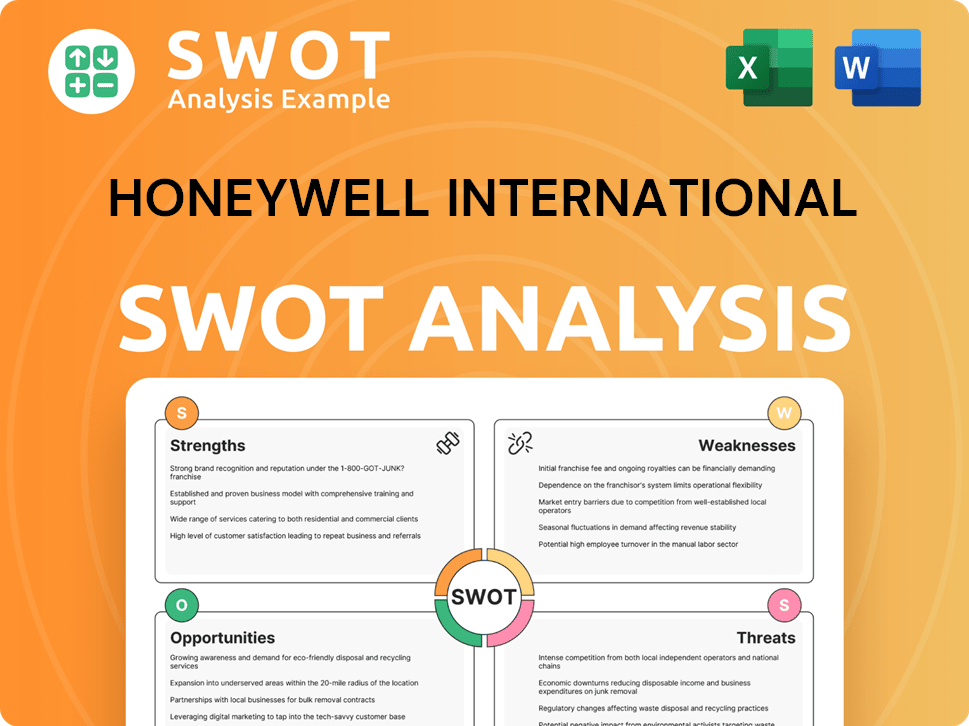
How Does Honeywell International Make Money?
The Honeywell International company generates revenue through a diverse range of avenues. It primarily relies on product sales, software subscriptions, and service contracts across its various business segments. This diversified approach helps Honeywell maintain financial stability and capitalize on different market opportunities.
A significant portion of Honeywell's revenue comes from selling products. These include a wide array of hardware components, such as those used in aerospace, building control systems, and safety equipment. The company also generates income from software subscriptions, service contracts, and licensing agreements, creating multiple streams of revenue.
In the first quarter of 2024, the Aerospace segment saw an organic sales increase of 3%, Building Technologies rose by 5%, Performance Materials and Technologies increased by 6%, and Safety and Productivity Solutions decreased by 6%. This demonstrates the varied contributions from each segment to the overall revenue, showcasing the company's diversified portfolio.
Beyond direct product sales, Honeywell emphasizes recurring revenue streams. Software subscriptions for platforms like building management and industrial process optimization offer a predictable revenue base. Service contracts in Aerospace and Building Technologies provide ongoing revenue through maintenance, repairs, and technical support. The company also monetizes its intellectual property through licensing agreements.
- Bundling hardware with software and services to offer comprehensive solutions.
- Tiered pricing models for software platforms based on features and usage.
- Cross-selling opportunities across diverse segments; for example, offering security solutions with building automation systems.
- Strategic focus on high-growth areas like automation and sustainable technologies, driving new revenue opportunities.
Honeywell International PESTLE Analysis
- Covers All 6 PESTLE Categories
- No Research Needed – Save Hours of Work
- Built by Experts, Trusted by Consultants
- Instant Download, Ready to Use
- 100% Editable, Fully Customizable
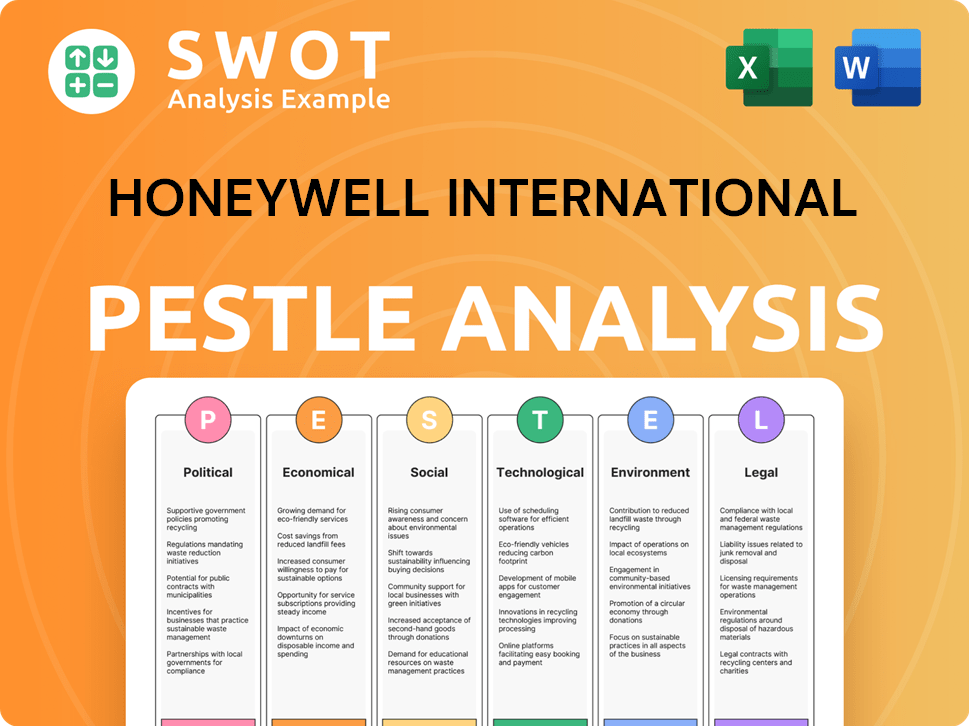
Which Strategic Decisions Have Shaped Honeywell International’s Business Model?
The operational evolution and financial performance of the Honeywell company have been significantly shaped by strategic milestones and adaptive responses to market dynamics. Their ongoing strategic focus is on automation, the energy transition, and the future of aviation, which are key growth drivers. This involves significant investments in research and development, strategic acquisitions, and divestitures to realign its portfolio. For instance, the spin-off of Resideo Technologies and Garrett Motion in 2018 allowed Honeywell to sharpen its focus on its core industrial and technology businesses.
The company has navigated various operational and market challenges, including supply chain disruptions, economic downturns, and shifts in regulatory landscapes. Its response typically involves optimizing its global supply chain, implementing lean manufacturing principles, and diversifying its customer base and geographic reach to mitigate regional economic volatility. Honeywell's competitive advantages are multifaceted: strong brand recognition, deep technological leadership, and significant economies of scale in manufacturing and procurement. Its vast installed base across numerous industries creates an ecosystem effect, fostering customer loyalty and providing opportunities for recurring service revenue. You can learn more about the company's origins in the Brief History of Honeywell International.
More recently, Honeywell has been actively pursuing strategic acquisitions to bolster its offerings in high-growth areas, such as its agreement to acquire Civitanavi Systems, a company specializing in inertial navigation systems, to enhance its aerospace navigation capabilities. Honeywell continues to adapt to new trends, such as the increasing demand for sustainable solutions and digital transformation, by investing in sustainable technologies and expanding its software offerings, ensuring its continued relevance and competitive edge in a rapidly changing global market.
Key milestones include the spin-off of Resideo Technologies and Garrett Motion in 2018, allowing Honeywell to focus on its core industrial and technology businesses. The company has also made significant acquisitions to strengthen its presence in high-growth sectors, such as the agreement to acquire Civitanavi Systems. These moves have helped to reshape the company's portfolio.
Strategic moves include a focus on automation, the energy transition, and the future of aviation. Honeywell invests heavily in research and development, strategic acquisitions, and divestitures. These actions help to optimize its global supply chain and implement lean manufacturing principles. The company is also diversifying its customer base and geographic reach.
The company's competitive advantages include strong brand recognition, technological leadership, and economies of scale. Honeywell has a vast installed base across numerous industries, fostering customer loyalty. The company also adapts to new trends by investing in sustainable technologies and expanding its software offerings. These factors ensure its continued relevance and a strong competitive position.
In 2024, Honeywell reported a revenue of approximately $38.1 billion. The company's adjusted earnings per share (EPS) were about $9.00. Honeywell continues to generate strong free cash flow, which supports its investments in innovation and strategic acquisitions. These figures reflect the company's solid financial health and strategic focus.
Honeywell's success is built on a foundation of technological innovation, strategic acquisitions, and a commitment to sustainability. The company's focus on automation and the energy transition positions it well for future growth. Honeywell leverages its extensive patent portfolio and strong brand recognition to maintain a competitive edge in the market.
- Technological Leadership: Extensive patent portfolios in critical industrial domains.
- Strategic Acquisitions: Bolstering offerings in high-growth areas.
- Sustainability Initiatives: Investing in sustainable technologies and solutions.
- Global Presence: Strong presence across various industries and geographies.
Honeywell International Business Model Canvas
- Complete 9-Block Business Model Canvas
- Effortlessly Communicate Your Business Strategy
- Investor-Ready BMC Format
- 100% Editable and Customizable
- Clear and Structured Layout
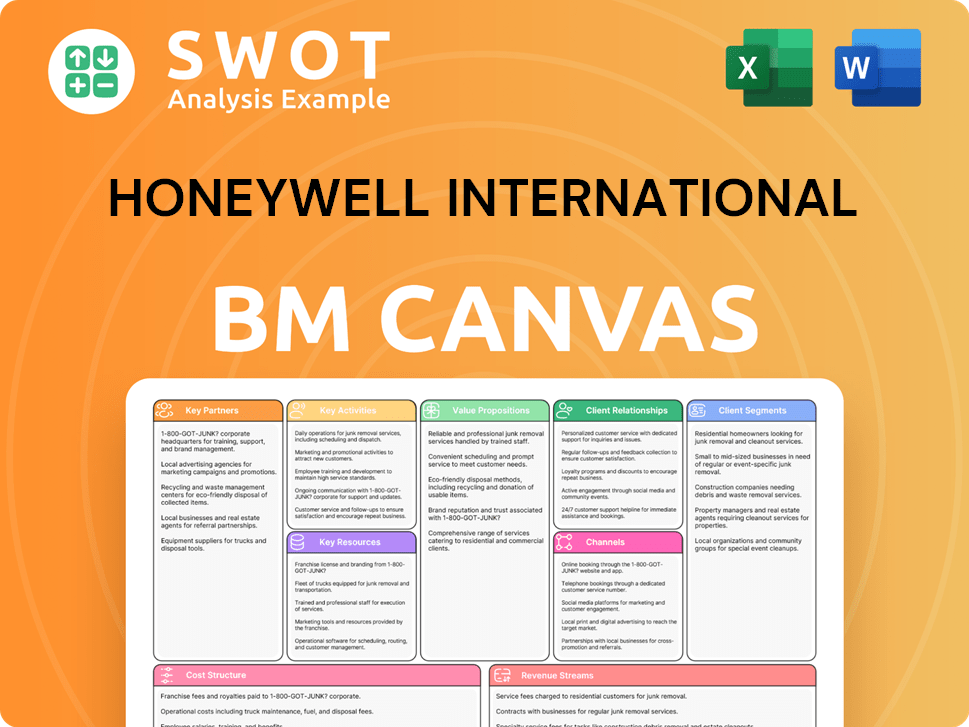
How Is Honeywell International Positioning Itself for Continued Success?
The Honeywell International company holds a strong industry position as a leading global technology and manufacturing firm. It competes with specialized players in various segments, leveraging its broad portfolio and integrated solutions. The company's global reach and customer loyalty further solidify its standing. Let's explore how Honeywell works and its current standing.
Despite its strengths, Honeywell faces risks such as cyclical markets, geopolitical instability, and intense competition. Cybersecurity threats and regulatory changes also pose challenges. However, the company is strategically focused on automation, the future of aviation, and energy transition to mitigate these risks and maintain its competitive edge.
Honeywell operates in diverse sectors, including aerospace, building technologies, and performance materials. It competes with companies like Raytheon Technologies and Siemens. Its wide range of products and services, coupled with a global presence, gives it a strong market position.
Honeywell faces cyclical market risks, particularly in aerospace and industrial sectors. Geopolitical instability and intense competition demand continuous innovation. Cybersecurity threats and regulatory changes also pose operational challenges.
Honeywell is focusing on automation, aviation, and energy transition. The company invests in sustainable aviation fuel technologies and smart building solutions. Strategic acquisitions and global expansion will support continued growth and profitability.
Honeywell is concentrating on automation, the future of aviation, and energy transition. The company is developing sustainable aviation fuel (SAF) technologies and smart building solutions. These areas are key to Honeywell's long-term growth strategy.
In recent financial reports, Honeywell has demonstrated consistent revenue growth. The company's strategic focus on high-growth areas like automation and sustainable technologies is expected to drive future performance. Honeywell's commitment to operational excellence and strategic acquisitions supports its long-term goals.
- Honeywell's revenue in 2023 was approximately $37.7 billion.
- The company is actively pursuing acquisitions to expand its portfolio.
- R&D investments are focused on innovation in key sectors.
- Honeywell is expanding its presence in high-growth geographies.
Honeywell International Porter's Five Forces Analysis
- Covers All 5 Competitive Forces in Detail
- Structured for Consultants, Students, and Founders
- 100% Editable in Microsoft Word & Excel
- Instant Digital Download – Use Immediately
- Compatible with Mac & PC – Fully Unlocked
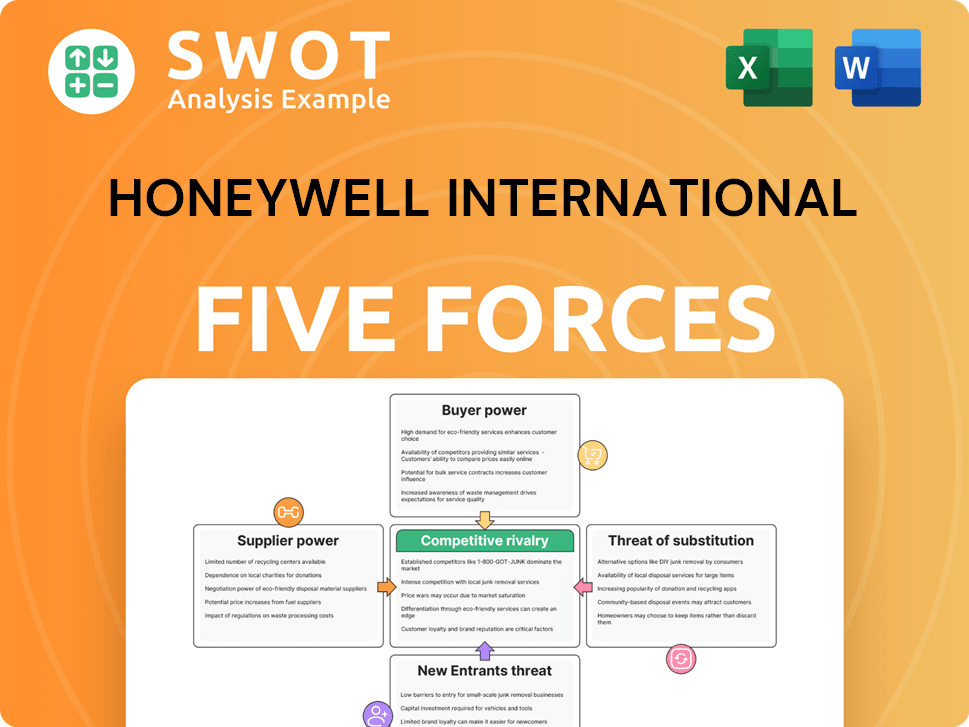
Related Blogs
- What are Mission Vision & Core Values of Honeywell International Company?
- What is Competitive Landscape of Honeywell International Company?
- What is Growth Strategy and Future Prospects of Honeywell International Company?
- What is Sales and Marketing Strategy of Honeywell International Company?
- What is Brief History of Honeywell International Company?
- Who Owns Honeywell International Company?
- What is Customer Demographics and Target Market of Honeywell International Company?
Disclaimer
All information, articles, and product details provided on this website are for general informational and educational purposes only. We do not claim any ownership over, nor do we intend to infringe upon, any trademarks, copyrights, logos, brand names, or other intellectual property mentioned or depicted on this site. Such intellectual property remains the property of its respective owners, and any references here are made solely for identification or informational purposes, without implying any affiliation, endorsement, or partnership.
We make no representations or warranties, express or implied, regarding the accuracy, completeness, or suitability of any content or products presented. Nothing on this website should be construed as legal, tax, investment, financial, medical, or other professional advice. In addition, no part of this site—including articles or product references—constitutes a solicitation, recommendation, endorsement, advertisement, or offer to buy or sell any securities, franchises, or other financial instruments, particularly in jurisdictions where such activity would be unlawful.
All content is of a general nature and may not address the specific circumstances of any individual or entity. It is not a substitute for professional advice or services. Any actions you take based on the information provided here are strictly at your own risk. You accept full responsibility for any decisions or outcomes arising from your use of this website and agree to release us from any liability in connection with your use of, or reliance upon, the content or products found herein.